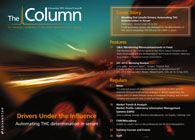Methamphetamine Analogue Found in Dietary Supplement
Potentially dangerous levels of the methamphetamine analogue, N, ??diethyl?phenylethylamine (N, ? -DEPEA), have been detected in a widely available dietary supplement using ultrahigh-pressure liquid chromatography coupled to mass spectrometry (UHPLC–MS). The supplement, Craze, can be bought in the USA and from on-line retailers. The findings have been published in the journal Drug Testing and Analysis by a team of scientists from Harvard Medical School (Massachusetts, USA), NSF International (Missouri, USA), and the National Institute for Public Health and the Environment Health Protection Center (Bilthoven, The Netherlands).1
Potentially dangerous levels of the methamphetamine analogue, N, α ‑diethyl‑phenylethylamine (N, α -DEPEA), have been detected in a widely available dietary supplement using ultrahigh-pressure liquid chromatography coupled to mass spectrometry (UHPLC–MS). The supplement, Craze, can be bought in the USA and from on-line retailers. The findings have been published in the journal Drug Testing and Analysis by a team of scientists from Harvard Medical School (Massachusetts, USA), NSF International (Missouri, USA), and the National Institute for Public Health and the Environment Health Protection Center (Bilthoven, The Netherlands).1
According to the paper, the study was initiated after a number of athletes failed urine drug screening tests after testing positive for N,α-DEPEA, a banned substance. “Designer drugs” have received increasing attention over recent years as concerns have been raised over the safety of “legal highs” - chemical compounds that are structurally analogous to existing illegal drugs, but have yet to be characterized.
Lead author of the paper Pieter Cohen said: “In recent years banned and untested drugs have been found in hundreds of dietary supplements. We began our study of Craze after several athletes failed urine drug tests because of a new methamphetamine analogue.”
The supplement in question was labelled to contain N,N-diethyl-phenylethylamine (N,N-DEPEA), a compound reported by the manufacturer to be derived from endangered orchids. However, the compound is structurally similar to the banned methamphetamine analogue, N,α-DEPEA. Samples were taken from three different sources purchased in the USA, from an on-line retailer, and from a supplier in Holland to rule out accidental contamination. UHPLC–MS was performed and identified 21 mg to 35 mg of N,α-DEPEA per serving in all three lots.
Cohen said: “The phenylethylamine we identified in Craze, N, α-DEPEA, is not listed on the labelling and it has not been previously identified as a derivative of dendrobium orchids.” He added: “If these findings are confirmed by regulatory authorities, the FDA [U.S. Food and Drug Administration] must take action to warn consumers and to remove supplements containing N,α-DEPEA from sale.” &mdash B.D.
Reference
1. P. Cohen, J.C. Travis, and B.J. Venhuis, Drug Testing and Analysis DOI: 10.1002/dta.1578 (2013)


.png&w=3840&q=75)

.png&w=3840&q=75)



.png&w=3840&q=75)



.png&w=3840&q=75)










